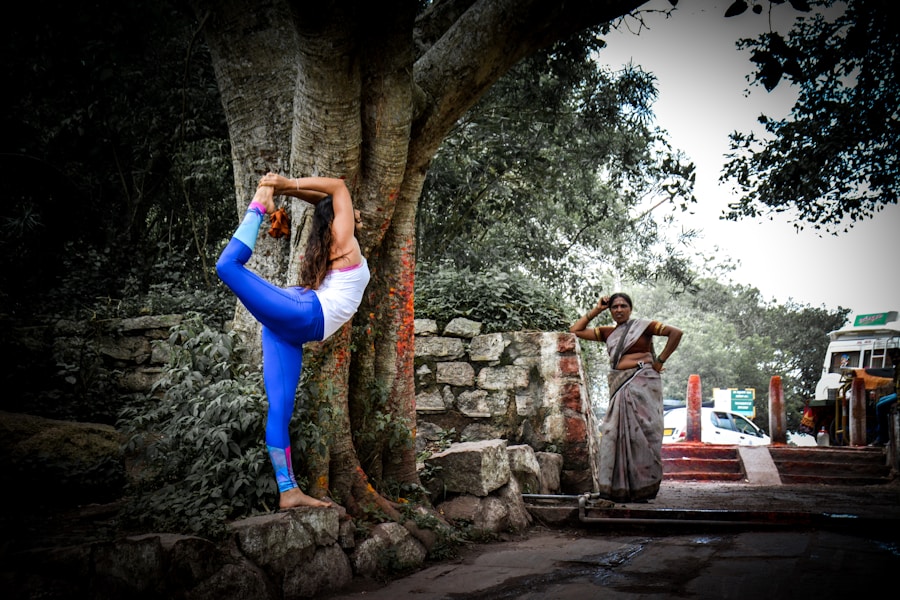The philosophy of yoga is a profound and intricate system of thought that extends far beyond the physical postures commonly associated with it. Rooted in ancient Indian traditions, yoga encompasses a wide array of practices and beliefs aimed at achieving a harmonious balance between the mind, body, and spirit. The term “yoga” itself is derived from the Sanskrit word “yuj,” which means to unite or join.
This unification is not merely a physical endeavor; it represents the integration of individual consciousness with universal consciousness, a theme that resonates throughout various philosophical texts, including the Yoga Sutras of Patanjali. At its core, yoga is about self-realization and understanding one’s true nature. The eight limbs of yoga, as outlined by Patanjali, provide a comprehensive framework for this journey.
These limbs include ethical precepts (Yama and Niyama), physical postures (Asana), breath control (Pranayama), sensory withdrawal (Pratyahara), concentration (Dharana), meditation (Dhyana), and ultimately, enlightenment (Samadhi). Each limb serves as a stepping stone toward achieving a deeper connection with oneself and the universe. The philosophical underpinnings of yoga encourage practitioners to explore their inner landscapes, fostering a sense of awareness that transcends the superficial aspects of life.
Key Takeaways
- Yoga is a philosophy that encompasses physical, mental, and spiritual practices aimed at achieving inner peace and harmony.
- The practice of yoga involves various physical postures, breathing exercises, and meditation techniques to promote inner peace and well-being.
- Yoga serves as a powerful tool for stress reduction by helping individuals to release tension, calm the mind, and improve overall mental and emotional well-being.
- Through yoga, individuals can cultivate mindfulness and presence by focusing on the present moment and developing a deeper awareness of their thoughts, emotions, and sensations.
- By incorporating yoga into a daily routine, individuals can find lasting peace, balance, and harmony in their lives, leading to improved overall well-being.
The Practice of Yoga for Inner Peace
Engaging in the practice of yoga can be a transformative experience, offering practitioners a pathway to inner peace that is often elusive in today’s fast-paced world. Through the combination of physical movement, breath control, and meditation, yoga creates an environment conducive to introspection and tranquility. The physical postures, or asanas, are designed not only to strengthen and stretch the body but also to cultivate a sense of grounding and stability.
This physical foundation allows individuals to explore their mental and emotional states more freely, paving the way for deeper self-awareness. Moreover, the practice of yoga encourages individuals to cultivate a non-judgmental attitude towards themselves and their experiences. This acceptance is crucial for fostering inner peace, as it allows practitioners to let go of self-criticism and embrace their imperfections.
As one moves through various asanas, they learn to listen to their bodies and honor their limits, which can lead to a profound sense of liberation. The meditative aspects of yoga further enhance this journey towards inner peace by providing tools for quieting the mind and fostering a sense of stillness amidst external chaos. By dedicating time to this practice, individuals can create a sanctuary within themselves, where peace reigns supreme.
Yoga as a Tool for Stress Reduction

In an era characterized by relentless demands and constant connectivity, stress has become an all-too-familiar companion for many individuals. Yoga emerges as a powerful antidote to this pervasive issue, offering a holistic approach to stress reduction that addresses both the physiological and psychological aspects of stress. The practice of yoga activates the parasympathetic nervous system, which is responsible for the body’s relaxation response.
This activation leads to a decrease in heart rate, lower blood pressure, and reduced levels of stress hormones such as cortisol. The incorporation of breathwork into yoga practice plays a pivotal role in managing stress. Techniques such as deep diaphragmatic breathing and alternate nostril breathing help regulate the breath, which in turn calms the mind and reduces anxiety.
By focusing on the breath, practitioners can anchor themselves in the present moment, diverting attention away from stressors that may be overwhelming them. Additionally, the mindful movement inherent in yoga encourages individuals to release physical tension stored in the body, further alleviating stress. As practitioners flow through sequences of poses, they often find that they can let go of worries and distractions, creating space for clarity and calmness.
Cultivating Mindfulness and Presence through Yoga
Mindfulness is a cornerstone of yoga practice, serving as a bridge between physical movement and mental awareness. Through the deliberate focus on breath and body sensations during asana practice, individuals cultivate a heightened sense of presence that permeates all aspects of their lives. This mindfulness fosters an acute awareness of thoughts, emotions, and physical sensations without judgment or attachment.
As practitioners learn to observe their experiences with curiosity rather than criticism, they develop a deeper understanding of themselves and their reactions to external stimuli.
For instance, during moments of stress or anxiety outside of yoga practice, individuals can draw upon the techniques learned on the mat—such as conscious breathing or grounding techniques—to navigate challenging situations with greater ease.
This ability to remain present allows individuals to respond thoughtfully rather than react impulsively, leading to healthier relationships and improved emotional regulation. By integrating mindfulness into everyday activities—whether it be eating, walking, or engaging in conversation—individuals can cultivate a more profound sense of connection with themselves and others.
Finding Balance and Harmony through Yoga
The quest for balance is a universal pursuit that resonates deeply within the human experience. Yoga offers a unique framework for achieving this balance by emphasizing the interconnectedness of various aspects of life—physical health, emotional well-being, mental clarity, and spiritual growth. Through regular practice, individuals can learn to harmonize these elements, creating a more integrated sense of self.
The physical postures challenge practitioners to find equilibrium within their bodies while simultaneously encouraging them to explore their limits and capabilities. Moreover, yoga teaches the importance of balance not only within oneself but also in relation to the external world.
For example, practicing Ahimsa (non-violence) fosters compassion towards oneself and others, while Santosha (contentment) encourages acceptance of life’s circumstances. By embodying these principles both on and off the mat, individuals can create a more harmonious existence that reflects their values and aspirations.
Incorporating Yoga into a Daily Routine for Lasting Peace

Creating a Sanctuary for Practice
This space serves as a sanctuary where individuals can retreat from daily distractions and immerse themselves in their practice. To incorporate yoga into daily life effectively, one might consider setting aside specific times for practice—perhaps early in the morning to set a positive tone for the day or in the evening as a means of unwinding before sleep.
Exploring Yoga Styles and Mindfulness Practices
Additionally, exploring various styles of yoga can help keep the practice engaging; from dynamic Vinyasa flows that energize the body to restorative Yin sessions that promote relaxation, there is a style suited for every mood and need. Furthermore, integrating mindfulness practices such as meditation or breathwork into daily routines can enhance overall well-being and reinforce the principles learned through physical practice.
Unlocking the Benefits of Yoga
In conclusion, embracing yoga as part of daily life offers profound opportunities for personal growth and transformation. By understanding its philosophical roots, engaging in mindful practices for inner peace, utilizing it as a tool for stress reduction, cultivating presence through mindfulness, finding balance in life’s complexities, and establishing consistent routines, individuals can unlock the myriad benefits that yoga has to offer. Through this journey, practitioners not only enhance their own well-being but also contribute positively to their communities by embodying peace and harmony in their interactions with others.
Yoga as a Pathway to Peace is a powerful practice that can lead individuals to inner harmony and tranquility. In a related article exploring the nature of reality and human existence, Vedanta Philosophy delves into the deep questions of existence and the nature of reality. This philosophical perspective can complement the practice of yoga by providing a deeper understanding of the self and the world around us. To read more about Vedanta Philosophy, check out this article.
FAQs
What is yoga?
Yoga is a physical, mental, and spiritual practice that originated in ancient India. It involves a combination of physical postures, breathing techniques, and meditation to promote overall health and well-being.
How does yoga promote peace?
Yoga promotes peace by helping individuals to cultivate a sense of inner calm, balance, and harmony. Through the practice of yoga, individuals can learn to manage stress, reduce anxiety, and develop a greater sense of self-awareness and compassion.
What are the benefits of practicing yoga for peace?
Practicing yoga can lead to a variety of benefits for peace, including reduced stress, improved mental clarity, enhanced emotional well-being, and a greater sense of connection to oneself and others. Additionally, yoga can help individuals develop a more positive outlook on life and cultivate a greater sense of inner peace.
Can anyone practice yoga?
Yes, yoga is a practice that can be adapted to suit individuals of all ages, fitness levels, and abilities. There are many different styles and variations of yoga, making it accessible to a wide range of people.
Is yoga a religious practice?
While yoga has its roots in ancient spiritual traditions, it is not inherently a religious practice. Many people practice yoga purely for its physical and mental health benefits, without any specific religious or spiritual beliefs. However, for some individuals, yoga can be a deeply spiritual practice.






















+ There are no comments
Add yours